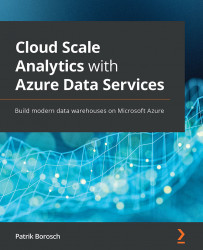Implementing an ASA job
ASA offers you a convenient way to create streaming analysis on a configuration basis. This means you do not need to code the environment, the engine, the connection, logging, and so on. The service will take care of all these tasks for you (to see an example, refer to the Integrating sources and Writing to sinks sections that follow). The only thing you will need to code is the analytical core of your streaming job. To ease things for you, this is done using a SQL dialect that was tailored for this task (see Understanding ASA SQL).
After the provisioning of your new resource, you are taken to the following overview blade:
Figure 8.2 – Overview blade of the ASA job
You can already see three of the most important areas of your ASA job:
- Inputs: This will show all the configured source connections available in your job.
- Outputs: This will show all the configured target connections available in your job.
- Query:...



